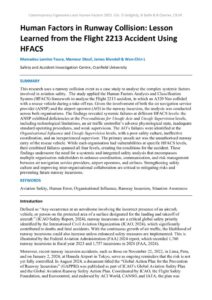| Document | Author Mamadou Lamine Toure, Mamour Diouf, James Blundell & Wen-Chin L |
| Abstract This research uses a runway collision event as a case study to analyse the complex systemic factors involved in aviation safety. The study applied the Human Factors Analysis and Classification System (HFACS) framework to analyse the Flight 2213 accident, in which an A320 Neo collided with a rescue vehicle during a take-off run. Given the involvement of both the air navigation service provider (ANSP) and the airport operator (AO) in the runway incursion, the analysis was conducted across both organisations. The findings revealed systemic failures at different HFACS levels: the ANSP exhibited deficiencies at the Preconditions for Unsafe Acts and Unsafe Supervision levels, including technological limitations, an air traffic controller’s adverse physiological state, inadequate standard operating procedures, and weak supervision. The AO’s failures were identified at the Organisational Influence and Unsafe Supervision levels, with a poor safety culture, ineffective coordination, and an inexperienced supervisor. The primary unsafe act was the unauthorised runway entry of the rescue vehicle. While each organisation had vulnerabilities at specific HFACS levels, their combined failures spanned all four levels, creating the conditions for the accident. These findings underscore the need for a systemic and integrated safety analysis that encompasses multiple organisation stakeholders to enhance coordination, communication, and risk management between air navigation service providers, airport operators, and airlines. Strengthening safety culture and improving inter-organisational collaboration are critical to mitigating risks and preventing future runway incursions. |

